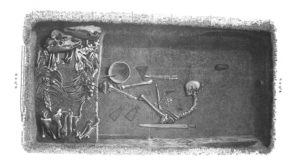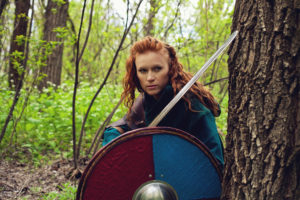There is a grave near the Swedish town of Birka that was the final resting place of a Viking warrior. The grave, called Bj 581, was filled with weapons, including a sword, battle knife, axe, armor-piercing arrows, a spear and two shields as well as a full set of gaming pieces with a board, and the skeletons of two horses—a mare and a stallion. First described in the late 1800s, this grave has been held up as the example of what a Viking warrior burial site would look like because it was so well furnished.

Although Viking lore describes mighty woman warriors fighting alongside men, when evaluations of the skeleton from Bj 581 pointed to the individual being female in the 1970s (1), the results were dismissed because the gender of warriors has always been identified as male (2,3). Last year a full osteological and contextual analysis of the Bj 581 skeleton agreed with that earlier skeletal analysis, concluding that the skeleton was that of a female (Kjellström, 2016). This osteological analysis generated debate among Viking scholars around the roles of gender and Viking warriors (1).
A recent article published in the American Journal of Physical Anthropology (1) used DNA analysis to resolve once and for all the gender of the Viking warrior buried in grave Bj 581. The authors of the study isolated DNA from the left canine and left humerus of the skeleton. They used the DNA to create blunt-end Illumina genomic libraries for shotgun sequencing (1). Gender assignment was based on the ratio of sequences that aligned to the X and Y sex chromosomes. Genome-side sequencing was used to find genetic similarities between the Bj 581 individual and historical and modern local populations. Contradictory positions in mitochondrial DNA sequences were used to estimate contamination. To determine if the warrior was originally from Birka region, they used Strontium isotope analysis of three molars from the lower jaw of the skeleton.
DNA sequencing results showed that the Bj 581 skeleton was female. Both the results for sex identification and mitochondrial analysis showed that the results are from a single individual. The female Viking showed genetic affinity to the peoples of the British Islands, the North Atlantic Islands (Iceland and the Orkneys), Scandinavia and somewhat to Eastern Baltic Europe. Notably, all these regions were once located in the Viking world. The strontium isotope values for the teeth fell outside the local baseline, which suggests that the Viking woman most likely moved there.
For decades, grave site Bj 581 has been considered one of the best examples of a high-ranking Viking warrior burial site. Viking scholars are now debating what the findings confirming the female gender of the buried individual might mean for their interpretation of burial sites such as this, as well as their conclusions about women’s role in the Viking culture. Bj 581 is one of three known examples of women buried with all the trappings of a male warrior—and notably lacking items that would be associated with a typical female role (Jesch, 2009). These sites suggest that the woman in the Viking culture could, and did, assume what we would describe as traditional male roles.

